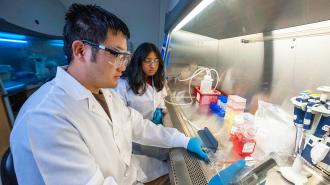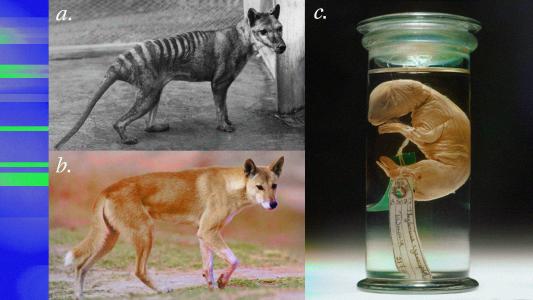By splitting a CRISPR-based gene-editing tool into two parts, researchers were able to give it an “on/off” switch that appeared to make it safer and more effective.
The challenge: Your DNA looks like a long, twisted ladder, and each of the 3.2 billion rungs on it is made up of a pair of two chemical bases: either adenine (A) and thymine (T), or cytosine (C) and guanine (G).
A mistake in one base pair in your DNA — an A-T where there should be a G-C, for example — is called a point mutation, and such flubs are responsible for thousands of diseases, including certain cancers, sickle-cell anemia, and potentially lupus.
“Current adenine base editors are in a constant ‘on’ state, which could lead to unwanted genome changes.”
Hongzhi Zeng
While some CRISPR tools slice through both sides of the DNA ladder to make changes, this can cause collateral damage. Base editors use parts of a CRISPR system to alter just one letter in a base pair — changing an A to a G, for example — to correct a point mutation without cutting through the whole DNA double helix.
Base editors are less likely to make off-target edits than tools that cut both strands of DNA and are already being trialed in people. However, like other gene-editing tech, they can still make mistakes or fail to edit enough cells to make a difference in a disease.
What’s new? Researchers at Rice University have developed a new adenine base editor, meaning one that switches an A-T pair to a G-C pair, which is the cause of about half of all point-mutation diseases.
According to their study, published in Nature Communications, the new base editor was more precise and easier to control than an existing system in tests in mice and human cell cultures — thanks to a built-in “on/off” switch.
“[C]urrent adenine base editors are in a constant ‘on’ state, which could lead to unwanted genome changes alongside the desired correction in the host genome,” said lead author Hongzhi Zeng.
“Our team set out to create a much improved version that can be turned on or off as needed, providing an unparalleled level of safety and accuracy,” he continued.
“Our version reduces overall off-target edits by over 70% and increases the accuracy of on-target edits.”
Hongzhi Zeng
How it works: To create their new base editor, the Rice team split an existing A-to-G base editor (called ABE8e) into two parts. They then fused one part to one protein and the other to a different protein.
After delivering the two pieces of their base editor separately, they administered an FDA-approved cancer medication called rapamycin. This caused the proteins to come together, activating the base editor. When the drug is used up, the editor stops working.
“As the body metabolizes the rapamycin, the two fragments disjoin, deactivating the system,” said Zeng. “Compared to an intact [ABE8e] editor, our version reduces overall off-target edits by over 70% and increases the accuracy of on-target edits.”
Looking ahead: Tests in human cells and mice are just the first steps in development, but the researchers are hopeful that their split base editor will prove to be a useful tool in the fight against diseases caused by point mutations.
“We hope to see the eventual application of our split genome-editing tool with higher precision to address human health-related questions in a much safer way,” said Xue Sherry Gao, leader of the lab that developed the new base editor.
We’d love to hear from you! If you have a comment about this article or if you have a tip for a future Freethink story, please email us at [email protected].






